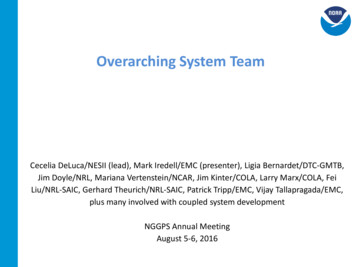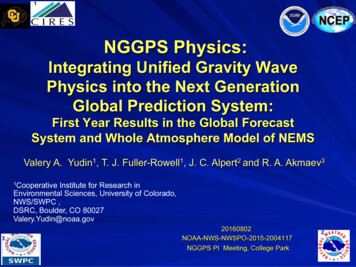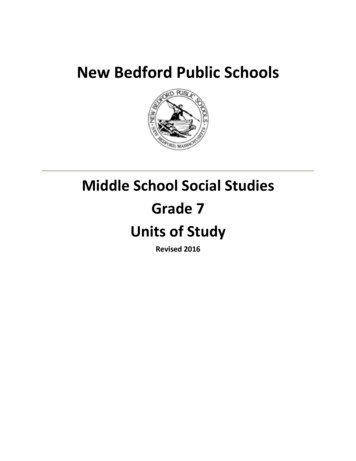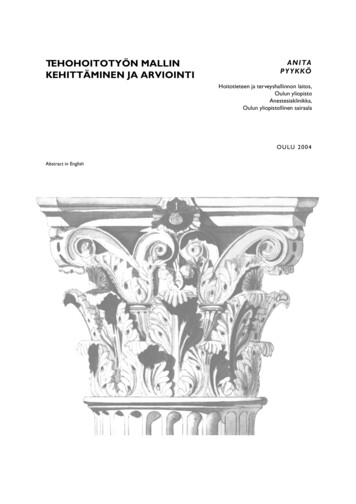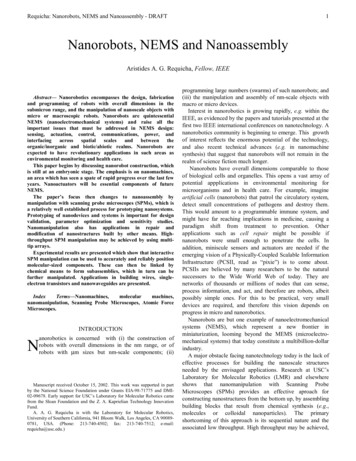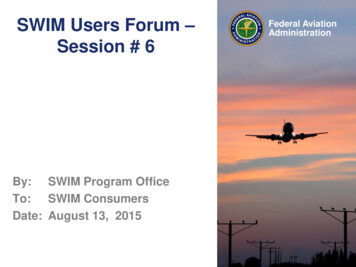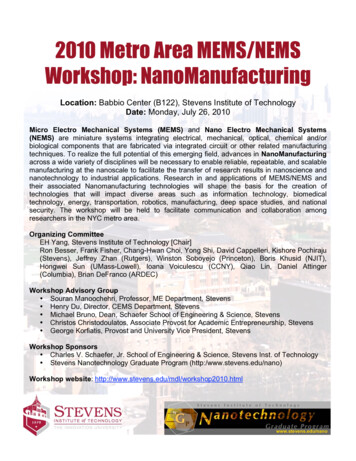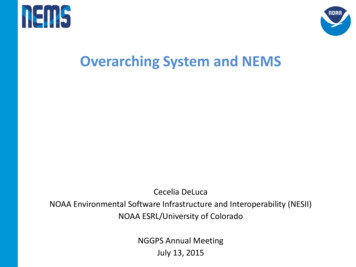
Transcription
Overarching System and NEMSCecelia DeLucaNOAA Environmental Software Infrastructure and Interoperability (NESII)NOAA ESRL/University of ColoradoNGGPS Annual MeetingJuly 13, 2015
Outline Overarching System Team NEMS and Model Coupling Code Management and R2X
NGGPS System ElementsNGGPS software delivery requires coordination across efforts: Integrative goals for science, predictive skill, and products Model component development Model component coupling Atmospheric physics and dynamics interface Workflow suite software elements (e.g. data assimilation, pre- and postprocessing) Code management and repository strategy Performance and memory optimization R2X strategy
Changes in ApproachCurrent development at EMC differs from previous efforts in (at least)three major ways:1.EMC anticipates leveraging more community–developed modelingcomponents, and using development strategies based on communitymodeling (e.g. objective evaluation of components).2.There are more model components anticipated than in previous EMCmodeling systems, including wave and separate land components.3.EMC is building a unified infrastructure – the NOAA EnvironmentalModeling System, or NEMS – to support multiple modelingapplications and predictive time scales.NEMS ouplednems/
NEMS Basics The NOAA Environmental Modeling System (NEMS) is infrastructurefor building coupled modeling systems‐ Examples of other coupled modeling systems: UK Met OfficeUnified Model, Community Earth System Model (CESM) NEMS is associated with a collection of model components External model components have a primary repository that is notat EMC In general, model components exchange data using the main NEMSmediator – often called a "coupler“ Custom NEMS mediators are being built for special interactions,such as optimized 3D coupling of the upper atmosphere to theionosphereIntroduction to dnems/introduction
NEMS Modeling Applications The model components in NEMS can be assembled into a number ofdifferent modeling applications, each associated with:‐ a purpose, such as seasonal forecasting‐ a set of model components‐ a set of parameters that represents a range of supportedoptions, including grids and resolutions Different NEMS modeling applications can have different types andnumbers of model components The same physical domain may be represented by different modelcomponents in different modeling modeling applications:‐ For example, in some NEMS modeling applications the oceancomponent may be HYCOM and in others it may be MOM5Spreadsheet of NEMS modeling d/1RS-fTBYnfSIWrJYfalD2lAIbUOGM0frNPEMIO ND28/edit#gid 0
Modeling Applications and ComponentsNGGPS / UGCS-Weather share components with other NEMS applications, so aholistic view of development is needed
Overarching System TeamThree main areas of activity: Model coupling Code management Coordination across NGGPS system elementsCharged with creating an associated 5-year plan to address thedevelopment of the overall framework for the NGGPS
Overarching System TeamCecelia DeLuca ESRL/CIRES/NESIILigia Bernadet NCAR DTCAnthony Craig contracting for NESIIJim Doyle NRL MRYMark Iredell NCEP EMCJohn Michalakes NOAA NWSGerhard Theurich Fei Liu NRL/NESIIMariana Vertenstein NCAR CGD/CESMIn coordination with EMC and external model component leads modeling application leads, including NGGPS science/product lead
Outline Overarching System Team NEMS and Model Coupling Code Management and R2X
NEMS Infrastructure NEMS is built using Earth System Modeling Framework (ESMF)infrastructure software, which provides: generation and application of interpolation weights, timemanagement classes, and other utilities data structures for representing fields, grids, and modelcomponents in a standard way The National Unified Operational Prediction Capability (NUOPC) Layerincreases interoperability by adding behavioral rules to ESMF, including:‐ a standard way of representing build dependencies‐ a standard syntax for initialization and run phases NUOPC wrappers or “caps” contain translations of native data structures(e.g. grids, field data, time quantities) into ESMF data structures.ESMF site: https://www.earthsystemcog.org/projects/esmf/NUOPC Layer site: ormance reports: rmance
National Unified OperationalPrediction Capability ConventionsNUOPC Layer rules are implemented using a set of generic components thatrepresent the major structural pieces needed to build coupled modelsNUOPC Generic ComponentsDriverConnectorModelMediatorFrom Theurich et al., submitted 2015
CESM as a NUOPC ApplicationNUOPC avModel:Model:GLCLNDxlnddlndslndclmcesm NUOPC models and mediators are implemented as wrappers around existing CESMcomponents and coupler/driver internals There are still issues (e.g. with passing scalars) that make the system not fullycompliant, though it is bfb with the original implementation.
NEMS as a NUOPC ApplicationxipmipeModel:IPMATMNUOPC del:OCNnems Grayed out components are in progress. The NEMS mediator is used instead of the CESM HMxchmgocartcmaq
Earth System Prediction Suite StatusLEGENDCompliantNEMS(Completion date) In progressCoupled Modeling SystemsCOAMPS 2015AtmospheresGFS/GSMNMMBCAMFIMGEOS-5 FVModelE AtmCOAMPS The Earth System Prediction Suite (ESPS) is a collection of major weather and climatemodeling codes that use ESMF interfaces with the NUOPC conventions
NEMS Mediator Currently set up for atmosphere-ocean-ice coupling, with stubs forwave, hydrology, and land components Slow (ocean) and fast (atmosphere and ice) coupling periods The mediator includes the following functions: Connects fields whose standard names match Accumulates and averages atmosphere and ice fields between callsto the ocean model Merges fields with a generic merge method that allows forweighting Performs custom coupling operations, along with unittransformations Performs interpolation (fluxes are mapped bilinearly, statesconservatively, higher order also available)More information about the uplednems/mediator designWorksheet of planned coupling fields across all modeling t#gid 0
Sample NEMS Configure File################################# NEMS Run Time Configuration File ################################## MED #med model:nemsmed petlist bounds:60 65#ATM#atm model:gsmatm petlist bounds:Processor layout0 31# OCN #ocn model:ocn petlist bounds:mom532 55# ICE #ice model:ice petlist bounds:cice56 59Processor layout# Run Sequence #runSeq::@7200.0OCN - MEDMED MedPhase slowMED - OCNOCN@3600.0MED MedPhase fast beforeMED - ATMMED - ICEATMICEATM - MEDICE - MEDMED MedPhase fast after@@::Colors show actionsperformed by: Connectors (- ) Mediator (MED) Models(@) indicates couplingtimesteps
Assembling NEMS Modeling ApplicationsNEMS AppBuilder: Enables users to construct a specific, versioned modeling applicationfrom a versioned set of model components and configuration files frommultiple locations. Helps to ensure that changes made to the different applications arecoordinated as they get checked back into the NEMS repository. Implemented using SVN externals, can be used with git repositoriesThe AppBuilder is based on low-levelterminal-based Unix utilities formaximum ease of use andportability. A command-line versionwill be available shortly.More about the couplednems/appbuilder
Running NEMS ApplicationsComponent sets (compsets): A labeling system originated by CESM to distinguish different runconfigurations for many-component modeling applications. Labels are associated with scripts that pull together all the files andinputs needed to run the specified configurations.‐ standard runs can be set up easily and consistently‐ effective way to implement regression testing across a coupledsystem with many possible combinations of components Each modeling application is typically associated with multiplecompsets.More about uplednems/compsets
Using CompsetsRunning Compsets:./NEMSCompsetRun [COMPSET LIST FILE]Compset syntax:caselabel architecture model1[%opt1[%opt2[.[%optN]]]] model2[.]. modelN[.]Where the file has the format:### List of compsets ###########################AMIP sbys gsm2009 nems gsm cice mom52011 sbys gsm%wam2011 sbys gsm%wam%ndsl!!!!stand-alone GSM - fake exampleNEMS mediator coupled GSM-CICE-MOM5stand-alone GSM run as WAMstand-alone GSM run as WAM with NDSLSupported uplednems/supported compsets
UGCS Seasonal 0.1 Milestone A first version (0.1) of the Unified Global Coupled System (UGCS)targeting seasonal prediction was completed in June 2015. Three-way coupled atmosphere-ocean-ice system with GSM (T126) MOM5 (1 deg) –CICE (1 deg)GSM to CICEGSM to MOM5ATMwind, stresssurface pressureGSMlowest level temperaturemerged momentum fluxspecific humiditymean net longwavelowest height, radiationbanded shortwave radiationCICE to GSM precipitationprecipitationderived air densityice fractionMOM5toGSMsensible heat fluxmasking informationSSTmore fields will beincluded hereOCNMOM5MOM5 to CICEocean currents, SSTCICE to MOM5merged momentum fluxICECICE
UGCS-Seasonal 0.1 Initial Tests Image courtesy of Fei Liu, NOAA CIRESSST after 5 days of a 15 day runFocus so far has been on technical correctnessModel initialization is not fully in placeNext steps focus on adding grid resolutions and initializing from CFSR socomparative runs with CFSv2 can begin
Running UGCS-Seasonal 0.1Run this test system by:1. Use the AppBuilder to assemble UGCS-Seasonal 0.1:svn co -r ps/UGCSSeasonal/trunk UGCS-Seasonal2.3.Select the compset: 2009 nems gsm cice mom5Change WLCLK and NDAYS variables to the desired length of the runMore information about the UGCS-Seasonal 0.1 dnems/drev58214
Outline Overarching System Team NEMS and Model Coupling Code Management and R2X
Code and Repository Management Code management document initiated in early summer 2015 Motivation included:‐ clarifying and reconciling terminology‐ version control software protocol (e.g. git and SVN)‐ version control software service (e.g. VLab, github)‐ how to organize NEMS repository directories‐ how to coordinate with external components‐ treatment of model components vs workflow components‐ treatment of infrastructure software vs scientific software‐ etc. Document will continue to evolve - expect many sections addressed byfall 2015DRAFT NEMS code management pJ7T3XeW3zCnhRLTL5a3m4 3XIAUeThUPWD9Tg/edit#
Common Infrastructure for Modelingthe Earth (CIME) CIME is a github community repository for storing infrastructuresoftware Created by the CESM team but not specific to CESM software It includes: coupling software (currently CESM coupler) a scripting and testing environment non-scientific (data, stub) versions of model components fordevelopment and controlled experimentation Proposal to store the NEMS mediator in CIME, where it can be treatedlike other community-developed components NEMS components can be run within research workflows, withaccess to tests and diagnostics NEMS mediator can be tested with a variety of components NUOPC interfaces provide a link back to operational systems Issues with license and access requirements must be addressed
NEMS Mediator in CIMEA full standalone coupled model test environment can be downloadedand run, and non-scientific components replaced locally with prognosticversions
CIME-Enabled Research mpopNUOPC CLNDxlnddlndlisclmModel:Model:GLCCHMxchmgocartcmaq This is a proposal. Not all components will be able to work together! Scientific model component access is not handled through CIME. However, all components shown could interact in the same environment.
Cupid Development andTraining EnvironmentCupid is a tool designed to make ESMF training and developmentsimpler, faster, and more appealing NOAA CIRES, GA Tech, and NASA GISS/GSFC collaboration Funded through the NASA Computational Modeling Algorithmsand Cyberinfrastructure (CMAC) program – just received 2nd roundof funding (Rocky Dunlap/NOAA NESII lead) Plugin for Eclipse-based “Integrated Development Environment”or IDE Customized for ESMF applications with NUOPC conventions First release in February 2015More about Cupid: https://earthsystemcog.org/projects/cupid/
Cupid Development and Training Environment Cupid parses code and outlines coupled model structure Shows NUOPC compliance issues and generates code templates to satisfyNUOPC compliance
Coordination Weekly NEMS development call on Friday at 12MT/2ET – primarycoordination mechanism New weekly sea ice call on Tuesday at 10MT/12ET Weekly land/hydrology call on Thursday at 12MT/2ET Occasional code management document callsPlus Monthly overarching system team call, TBDMost links in this talk are accessible from the main NEMS ouplednems/
Thank you!Any questions?
Model: GLC Model: ROF Model: WAV Model: LND NUOPC models and mediators are implemented as wrappers around existing CESM components and coupler/driver internals There are still issues (e.g. with passing scalars) that make the system not fully compliant, though it is bfb with the original implementation. or cesm or NUOPC Driver Model: ICE .
